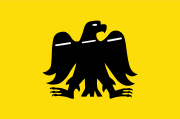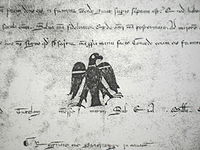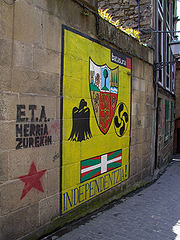
Arrano beltza
Encyclopedia





Basque people
The Basques as an ethnic group, primarily inhabit an area traditionally known as the Basque Country , a region that is located around the western end of the Pyrenees on the coast of the Bay of Biscay and straddles parts of north-central Spain and south-western France.The Basques are known in the...
and Navarre
Navarre
Navarre , officially the Chartered Community of Navarre is an autonomous community in northern Spain, bordering the Basque Country, La Rioja, and Aragon in Spain and Aquitaine in France...
symbol which shows a black eagle
Eagle
Eagles are members of the bird family Accipitridae, and belong to several genera which are not necessarily closely related to each other. Most of the more than 60 species occur in Eurasia and Africa. Outside this area, just two species can be found in the United States and Canada, nine more in...
upon a yellow background. Today it is mostly, though not exclusively, used by Basque nationalists
Basque nationalism
Basque nationalism is a political movement advocating for either further political autonomy or, chiefly, full independence of the Basque Country in the wider sense...
as a symbol of Euskal Herria, the Basque Country
Basque Country (historical territory)
The Basque Country is the name given to the home of the Basque people in the western Pyrenees that spans the border between France and Spain on the Atlantic coast....
.
History
The black eagle was originally the seal of King Sancho VII of NavarreSancho VII of Navarre
Sancho VII Sánchez , called the Strong or the Prudent, was the King of Navarre from 1194 to his death...
but was later attributed to Sancho III of Navarre
Sancho III of Navarre
Sancho III Garcés , called the Great , succeeded as a minor to the Kingdom of Navarre in 1004, and through conquest and political maneuvering increased his power, until at the time of his death in 1035 he controlled the majority of Christian Iberia, bearing the title of rex Hispaniarum...
who, when incorporating Aragon
Aragon
Aragon is a modern autonomous community in Spain, coextensive with the medieval Kingdom of Aragon. Located in northeastern Spain, the Aragonese autonomous community comprises three provinces : Huesca, Zaragoza, and Teruel. Its capital is Zaragoza...
and Castile
Kingdom of Castile
Kingdom of Castile was one of the medieval kingdoms of the Iberian Peninsula. It emerged as a political autonomous entity in the 9th century. It was called County of Castile and was held in vassalage from the Kingdom of León. Its name comes from the host of castles constructed in the region...
, had under his crown all the territories of Basque culture and language, including those traditionally Castilian, since his kingdom reached from Galicia to the Mediterranean Sea
Mediterranean Sea
The Mediterranean Sea is a sea connected to the Atlantic Ocean surrounded by the Mediterranean region and almost completely enclosed by land: on the north by Anatolia and Europe, on the south by North Africa, and on the east by the Levant...
. From a Basque nationalist interpretation, the rule of Sancho III constitutes a historical precedent for the aspirations of the unification of the Basque-speaking territories under one independent State. From a Spanish perspective, it is one of the first attempts at forming a unified Spain
Spain
Spain , officially the Kingdom of Spain languages]] under the European Charter for Regional or Minority Languages. In each of these, Spain's official name is as follows:;;;;;;), is a country and member state of the European Union located in southwestern Europe on the Iberian Peninsula...
.
Note that the flag is a modern interpretation of the seal.
There are no known flags prior to the 18th century when Father Isla describes a crimson flag with the chains and crown of the modern coat-of-arms.
Use by Basque nationalists
This symbol is used mostly by the so called Ezker AbertzaleaAbertzale
Abertzale in the Basque language means "patriot", and it is mainly used to mean "Basque nationalist". It comes from the fusion of aberri with the suffix -zale .Although the term is synonym of "patriot", its common use...
(Nationalist Left), who consider it "the oldest symbol of the territory of Euskal Herria". Such use fits in with the search for symbols and terms which go beyond the iconography created by Sabino Arana
Sabino Arana
Sabino Arana Goiri, self-styled as Arana ta Goiri'taŕ Sabin, , was a Spanish and Basque writer. He was the founder of the Basque Nationalist Party and father of Basque nationalism....
. Thus, besides the ikurriña
Ikurriña
The ikurrina flag or ikurriña is a Basque symbol and the official flag of the Basque Country Autonomous Community of Spain.-Design:...
(the official flag in the Basque Autonomous Community), of Aranist origin, one can find the yellow flag with the black eagle and the flag of Navarre being used more often, as they are considered more genuine symbols of Euskal Herria. For the same reason, these leftist abertzale
Abertzale
Abertzale in the Basque language means "patriot", and it is mainly used to mean "Basque nationalist". It comes from the fusion of aberri with the suffix -zale .Although the term is synonym of "patriot", its common use...
ak often use the traditional term Euskal Herria instead of the neologism Euskadi
Basque Country (autonomous community)
The Basque Country is an autonomous community of northern Spain. It includes the Basque provinces of Álava, Biscay and Gipuzkoa, also called Historical Territories....
, created by Sabino Arana in the 19th century. (Euskadi, on the other hand, is starting to be more usually identified with the Basque Autonomous Community.)
Occasional use by Spanish nationalists
Some Spanish nationalist organisations of neo-fascist character (specifically the AUNAun
Ane, On, One, Auchun or Aun the Old , English: Edwin, was a mythical Swedish king of the House of Yngling, the ancestors of Norway's first king, Harald Fairhair...
), have on a few occasions used the arrano beltza as well, presenting it as a symbol of Spanish unity. For this idea, they allege that Sancho III ruled most of Christian Spain, from León to Barcelona, and that he appeared in many documents named as Rex Hispanorum Regum, that is, "King of the Kings of the Hispania
Hispania
Another theory holds that the name derives from Ezpanna, the Basque word for "border" or "edge", thus meaning the farthest area or place. Isidore of Sevilla considered Hispania derived from Hispalis....
ns" (Spaniards), which, from their point of view, demonstrates that the Kingdom of Navarre
Kingdom of Navarre
The Kingdom of Navarre , originally the Kingdom of Pamplona, was a European kingdom which occupied lands on either side of the Pyrenees alongside the Atlantic Ocean....
perceived Spain as a territorial and historical unit, despite its political division (although it is debatable whether Hispania was then a merely geographical term, like its modern day substitute Iberia
Iberian Peninsula
The Iberian Peninsula , sometimes called Iberia, is located in the extreme southwest of Europe and includes the modern-day sovereign states of Spain, Portugal and Andorra, as well as the British Overseas Territory of Gibraltar...
).
See also
Arrano beltza is also a song by Basque songwriter Mikel LaboaMikel Laboa
Mikel Laboa Mancisidor was one of the Basque Country's most important singer-songwriters.Considered the patriarch of Basque music, his music has had an influence on younger generations...
(later covered by rock band Negu Gorriak
Negu Gorriak
Negu Gorriak were an underground Basque Crossover group. Their musical style combines various styles of rock music such as hardcore punk, hip-hop, ska, and reggae, although it is impossible to separate the band from its political ideology and its identification with the Basque Country and its...
), including the verses:
| Arrano beltzarekin joan ziren joan joan Jaengo Navas de Tolosara Nafarrak eta kate kateekin itzuli etxera. |
They went with the black eagle went, went to Navas de Tolosa Battle of Las Navas de Tolosa The Battle of Las Navas de Tolosa, known in Arab history as the Battle of Al-Uqab , took place on 16 July 1212 and was an important turning point in the Reconquista and in the medieval history of Spain... in Jaén the Navarrese and returned with the chains, chains. |
It alludes to a legend about the origin of the coat of arms and flag of Navarre.

